Agate


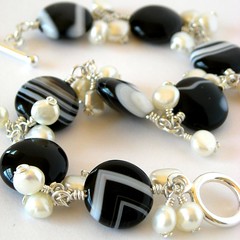
Colour: all colours, banded
Hardness: 6.5-7
Cleavage: none
Fracture: uneven
Crystal system: cryptocrystalline
Chemical composition: silicon dioxide
Transparency: translucent to opaque
Agate is banded chalcedony, with the bands multicoloured or the same colour. It has been used for at least 3000 years as a gemstone and for ornaments. Additionally, children’s marbles were once made of agate and were called “aggies” in reference to their composition.
Sardonyx , a banded brown- red/white stone is also a type of agate. Agate is generally found as ball or egg shaped nodules and geodes. Sometimes the interior can be encrusted with quartz crystals.
Agate takes to dye well, so many colours can be found although not all are colourfast after extended periods exposed to bright light.
Some of the best known agates are: blue lace agate, Botswana agate and crazy lace agate.
Metaphysical lore – in folklore, agate was considered a stable stone bringing about balance and harmonizing the male/female, yin/yang, positive/negative. Thought to be soothing and calming but with great strength it was believed to bring hidden information to light, to build self confidence and aid in self-analysis. In healing lore it was belived to stimulate the digestive process, strengthen blood vessels and heal skin disorders. Specifically, Botswana agate was believed to help find solutions rather than dwelling on problems; and blue lace agate was believed to be a healing stone, especially for the throat, and for bringing calm and peace of mind.
Amazonite
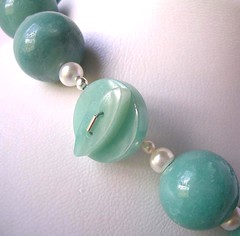
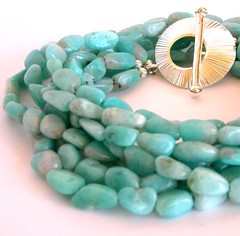
Colour: blue-green
Hardness: 6-6.5
Cleavage: perfect
Fracture: uneven, brittle, splintery
Crystal system: triclinic
Chemical composition: potassium aluminium silicate
Transparency: translucent to opaque
Colouring agent: lead
Amazonite is a form of alakali feldspar and is possibly named either after the courageous female Amazon warriors, or the belief that it was found in the Amazon river. It was used by the Egyptians who called it “uat” and used it for carvings where the colour color was associated with afterlife, fertility and protection from harm. Amazonite is thought to have been among the stones set into the priest’s breastplate, as described in the book of Exodus.
Amazonite is found in the USA, Brazil, Peru, India, Kenya, Madagascar, Canada, Tanzania, Mozambique, Namibia and Russia. The colour will often vary with location found eg. Peru tends to have quite bright teal coloured stones whereas Russian amazonite is more green and often with white inclusions.
It can be confused with chrysoprase, jade, serpentine and turquoise.
Metaphysically, amazonite was believed to protect against electromagnetic pollution. Some people consider it a soothing stone and helpful in maintaining optimum health, helping to alleviate worry and fear and dispel aggravation.
Amber


Hardness: 2-2.5
Cleavage: none
Fracture: conchoidal
Crystal system: amorphous
Chemical composition: tree/plant resin
Transparency: transparent to opaqueAmber is the fossilized resin of the pine tree Pinus succinifera, and range from 1 million to 360 million years old. Mostly found in nodules with a weathered surface, called ‘rind’, it has been found in pieces as large as 22lb/ 10kg. It has been used since prehistoric times for jewellery and amulets.
A lovely origin myth is that in the Garden of the Hesperides, golden apples grew and bestowed immortality to those who ate them. The dew from the apples was amber, gathered and sprinkled on the earth.
Pieces often have inclusions – air bubbles, liquids, occasionally other organic matter such as insects and plant material as well as tension fractures.
It is often found on the beaches of Baltic countries after heavy storms have disturbed the seabed where a large quantity of amber resides. It is also mined in Russia where it is found embedded in a layer of clay although the quality is lower than that of the Baltic amber. Other deposits are found in Italy, France, Spain, Germany, Czech Republic, Romania, Burma, China, the Dominican Republic, Japan, Canada, Mexico and the USA.
Ambroid is a natural looking pressed amber made from smaller pieces of natural amber which are heated to very highter temperatures into a solid piece. Copal is very young amber that hasn’t fully fossilized.
Amber can be heated in oil to clarify the inclusions. It can be confused with citrine, fluorite and ambroid. It is imitated by a number of synthetic resins and glass.
Amethyst
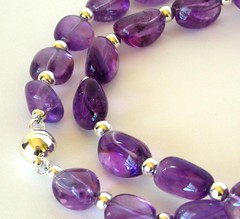
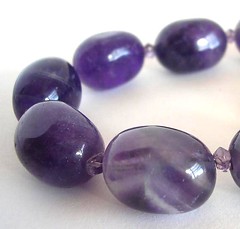
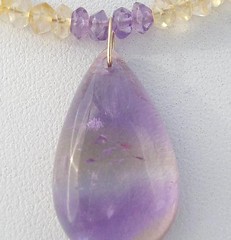
Hardness: 7
Cleavage: none
Fracture: brittle, conchoidal
Crystal system: trigonal
Chemical composition: silicon dioxide
Transparency: transparentAmethyst – the name means ‘not drunken’ in Greek, as it was worn as an amulet against drunkenness. The most highly valued of the quartz group, its colour varies from the softest lavender through to vibrant, regal purples and is best viewed in natural light.
Found worldwide, major deposits are in Brazil, Madagascar, Zambia, Uruguay, Burma, India, Canada, Mexico, Namibia, Russia, Sri Lanka and the USA. Amethyst can be heat treated to make citrine, green ‘amethyst’ and clear quartz.
Amethyst can also contain milky quartz and be transluscent to opaque. Ametrine is a colour zoned material consisting of amethyst and citrine. Pink amethyst (also called “rose de France” is very light pink to pinkish-mauve colored amethyst.
A famous legend exists about the origin of amethyst – Dionysus (Bacchus), the god of wine became enraged when a mortal refused him acknowledgment. In anger Dionysus vowed to unleash his fury upon all mortals who did not partake in his gifts of wine and drunkenness. The next mortal he saw was the young maiden Amethyst and Dionysis summoned two fierce tigers to devour the maiden and sat back with his wine to watch. Amethyst cried out to the goddess Diana who quickly transformed her to a glimmering pure white stone (quartz) to protect her. Realising his error Dionysus began to weep with sorrow. As the tears dropped into his goblet he collapsed and the tear-tainted wine ran out onto the stone. The white stone absorbed the color from the wine creating the stone now called amethyst.
It was also believed that amethyst could aid the soul as it journeys through through realms where visibility is low. It was also said to aid those souls left behind or those struggling.
Metaphysical healers believe amethyst is a powerful and protective stone with healing and cleansing powers that enhances spiritual awareness. They also suggest it could help focus and assimilation of new ideas, enhance memory and improve motivation. In healing it was believed to tune the metabolism, ease headaches and release tension. Accordintly, ametrine combined the powers of amethyst and citrine.
Andalusite
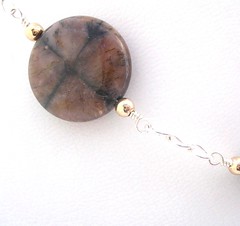
Hardness: 7.5
Cleavage: good
Fracture: uneven, brittle
Crystal system: orthorhombic
Chemical composition: aluminium silicate
Transparency: opaque to transparentNamed after the region of Andalusia in Spain where it is found. Gem quality is rare and it has a strong pleocrhrosim so that when turned the stone may appear yellow, green and red. It is found in Australia, Brazil, Canada, Russia, Spain, Sri Lanka and the USA. It can be confused with chrysoberyl, smoky quartz, sinhalite, sphene, tourmaline and idocrase.
Chiastolite is an opaque variety of andalusite that is softer at 5-5.5 and is found in long prisms that display a dark cross when sliced across the crystal. Found in Algeria, Australia, Bolivia, Chile, France, Russia, Spain and the USA.
In ancient times chastiolite was used to ward off curses. Considered a gateway into mysteries by those who consider the metaphysical qualities, it was used to change conflict into harmony, to assist in problem solving and help to adjust to change. It was also believed to calm fears, face reality, clears guilt and stablises the emotions.
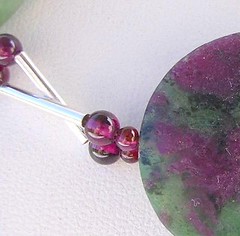
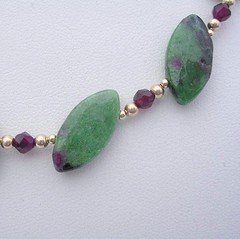
Hardness: 6.5-7
Cleavage: perfect
Fracture: uneven, brittle
Crystal system: orthorhombic but found in a massive form.
Chemical composition: calcium aluminium silicate
Transparency: opaqueFrom the Zoisite species and often referred to as Ruby Zoisite. The green background colour is zoisite and the inclusions of black (hornblende) and red (corrundum – ruby). The name anyolite is the Massai word for ‘green’.
Anyolite is believed by metaphysical healeres to facilitiate spiritual memory and learning.
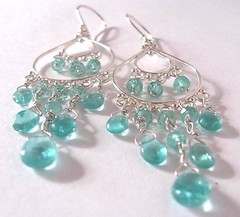
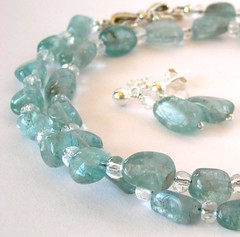
Colour: colourless, pink, yellow, green, blue, violet
Hardness: 5
Cleavage: indistinct
Fracture: conchoidal, brittle
Crystal system: hexagonal
Chemical composition: fluro and chloro calcium phosphate
Transparency: transparent.
From the Greek word to cheat as it can easily be confused! Found in Burma, Brazil, India, Kenya, Madagascar, Mexico, Norway, Sri Lanka, Russia, Canada, East & South Africa, Sweden, Spain and the USA. It can be confused with adalusite, berl, sphene, topaz and tourmaline.
In metaphysical circles apatite is considered to have inspirational properties. Healers believe it sees forward while retaining a connection to the past and aids communication. In healing one of its many properties is believed to be is its ability to suppress hunger and raise the metabolic rate.
Aquamarine
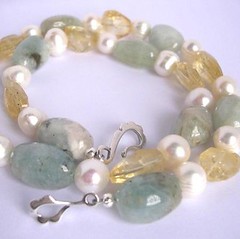
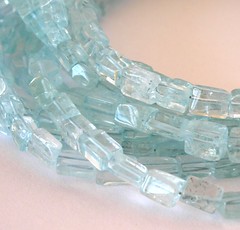
Hardness: 7.5-8
Cleavage: indistinct
Fracture: conchoidal, brittle, uneven
Crystal system: hexagonal
Chemical composition: aluminium beryllium silicate. Colouring agent – iron.
Transparency: transparent to opaqueAquamarine – a Latin word meaning water of the sea.
Sensitive to pressure and quite brittle, inclusions are common and treatment by heat is frequent. Found in Brazil, Russia, Australia, Burma, China, India, Kenya, Madagascar, Mozambique, Namibia, Nigeria, Zambia, Zimbabwe and the USA. The largest gem quality stone was found in the early 20th century in Brazil and weighed 110.5kg and was cut into stones totaling over 100,000 carats.
Aquamarine can be confused with euclase, kyanite, topaz, tourmaline and zircon. Glass imitations abound.
Metaphysical healers believe that aquamarine is a stone of courage that calms, reduces stress, clarifies perception, sharpens the intellect and clears confusion; promotes self expression and sharpens intiuition. Healers use it for sore throats, swollen glands and thyroid problems; to strengthen the bodys’ cleansing organs and aid the eyes, jaw, teeth and stomach; to assist the body to deal with allergies such as hay fever. In ancient days it was believed to counteract evil and was carried by sailors as a talisman against drowning.
Aventurine
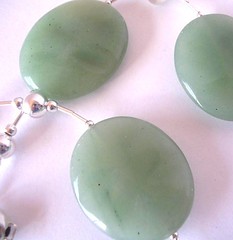

Colour: green, red-brown, gold-brown often with flecks of mica.
Hardness: 7
Cleavage: none
Fracture: brittle, conchoidal
Crystal system: massive
Chemical composition: silicon dioxide
Transparency: transparent to opaque
Aventurine, named after a type of glass that was discovered by accident in the 18th century by Venetian glassmakers, who dropped some copper filings into some molten glass producing a glass with sparkles. This glass was named a ventura and means ‘by chance’.
A type of quartz, aventurine’s characteristic glistening or shimmering effect is known as “aventurescence,” which is the result of uniformly oriented, platy mineral inclusions within the rock matrix – either mica or hematite.
Found in Russia, India, Brazil, Tanzania, Chile, Spain, Austria and USA. Green aventurine can be confused with emerald and jade. Orange aventurine can be confused with sunstone.
Metaphysical practioners believe aventurine is a stone of prosperity, that reinforces leadership qualities, promotes compassion and empathy and encourages perseverance. They also believe it stimulates perception and enhances creativity as well as balancing male/female energy. Metaphysical healers believe it benefits the nervious system, stimulates the metabolism, eases skin eruptions and allergies and soothes the eyes.
Azurite
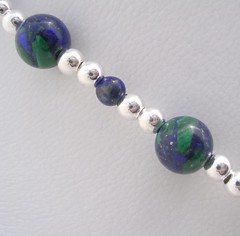
Hardness: 3.5-4
Cleavage: indistinct
Fracture: conchoidal, uneven, brittle
Crystal system: monoclinic and a massive form.
Chemical composition: copper carbonate
Transparency: transparent to opaqueNamed for its azure-blue colour, azurite often is found with malachite and near copper deposits. Ancient Egyptian priests used azurite paint to draw a third eye on their foreheads believing it would increase their powers.
Azurite is found in Australia, Chile, Africa, China, Mexico, Russia, France and the USA. Some dark indigo blue crystals have been found in Namimbia and Morocco.
Metaphysicall healers use to guide psychic and intuitive development; to assist people to go into the unknown without fear to reach deep insights and to see a new reality; to clear stress, worry, grief and sadness and encourage self-expression. Crystal healers use it for throat problems, arthritis, kidney, gallbladder and liver problems, spleen, thyroid, bones, teeth and skin as well as assisting during a healing crisis, when things get temporarily worse before getting better.
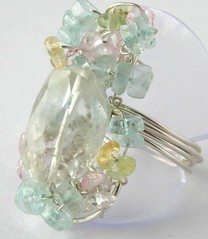
Colour: golden yellow, colourless, light yellow-green, pink
Hardness: 7.5-8
Cleavage: indistinct
Fracture: conchoidal, brittle
Crystal system: hexagonal
Chemical composition: aluminium beryllium silicate
Transparency: transparent to opaque
Beryl refers to all colour varieties of beryl that are not emerald or aquamarine.
Golden beryl and heliodor (the Greek word for ‘present of the sun’) are considered the same variety although heliodor tends to be paler and often with a little more green. Found in Namibia, Brazil, Madagascar, Nigeria, Zimbabwe, Sri Lanka.
Goshenite is colourless beryl and named after a locality in Goshen, Massachuesetts (USA). Found in Brazil, China, Canada, Mexico, Russia and the USA.
Morganite – soft pink to violet. Named after the American banker and collector J P Morgan. Can be heat treated. Found in Afghanistan, Brazil, China, Madagascar, Mozambique, Namibia, Zimbabwe and the USA.
Metaphysical practioners use beryl to deal with stress; to help focus; to encourage a positive viewpoint; and to reawaken love in established relationships. Metaphysical healers believe it aids the organs of elimination, strengthens the circulatory system and increases resistance to toxins and pollutants. Traditionally it was used a stone for scrying. Specific types of beryl: Golden/Helidor – was used as a seer’s stone that taught initiative and independence and stimulated potential into reality. Morganite – attracted love and maintained it as well as bringing calm and benefiting the nervous system. Crystal healers considered it a powerful stone for removing resistance to healing and transformation.
Please note: In keeping with Australian Fair Trading guidelines no therapeutic claims are made and no medical advice is offered. The material on metaphysical properties and beliefs, provided on annettepiper.com is for information and educational purposes only and is not a substitute for medical treatment or diagnosis. We assume no responsibility for treatment or cure of any illness or disease. If you have a health problem we recommend seeking medical advice from your qualified natural/health professional. This information is strictly a source of general information and is not intended for use as a tool for self-diagnosis.